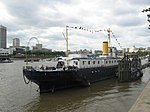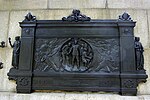Oxo Tower
Art Deco architecture in LondonBuildings and structures in the London Borough of SouthwarkCommercial buildings completed in 1900Contemporary art galleries in LondonEngvarB from October 2017 ... and 5 more
Observation towers in the United KingdomRecipients of Civic Trust AwardsRedevelopment projects in LondonResidential buildings in LondonTourist attractions in the London Borough of Southwark

The Oxo Tower is a building with a prominent tower on the south bank of the River Thames in London. The building has mixed use as Oxo Tower Wharf containing a set of design, arts and crafts shops on the ground and first floors with two galleries, Bargehouse and Gallery@oxo. The Oxo Tower Restaurant, Bar and Brasserie is on the eighth floor, which is the roof-top level with fine and casual dining. In addition to this, situated on the eighth floor is a viewing gallery open to the public. The third to seventh floors contain 78 flats owned by Redwood Housing. Much of the second floor can be hired out for events and weddings.
Excerpt from the Wikipedia article Oxo Tower (License: CC BY-SA 3.0, Authors, Images).Oxo Tower
Barge House Street, London Southwark (London Borough of Southwark)
Geographical coordinates (GPS) Address External links Nearby Places Show on map
Geographical coordinates (GPS)
| Latitude | Longitude |
|---|---|
| N 51.508272 ° | E -0.108547 ° |
Address
OXO Tower Wharf
Barge House Street
SE1 9PH London, Southwark (London Borough of Southwark)
England, United Kingdom
Open on Google Maps









